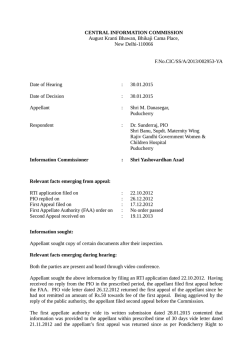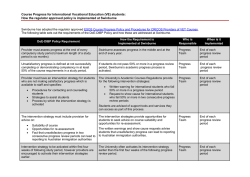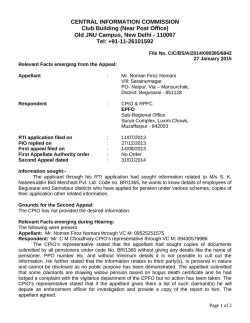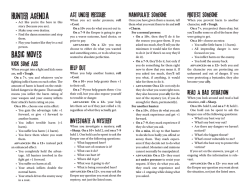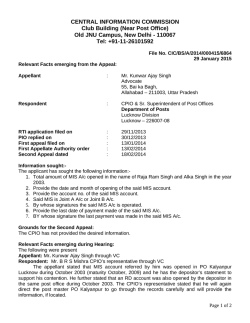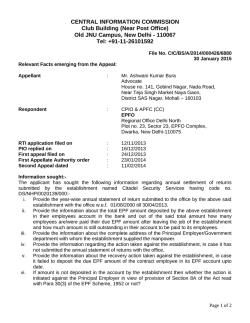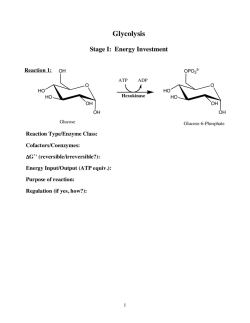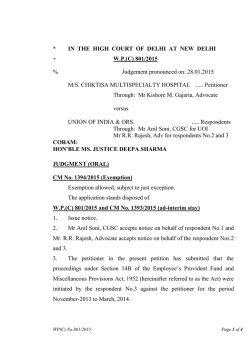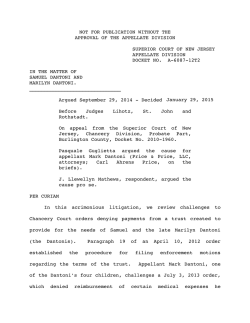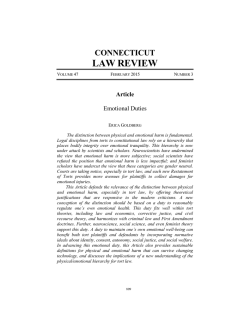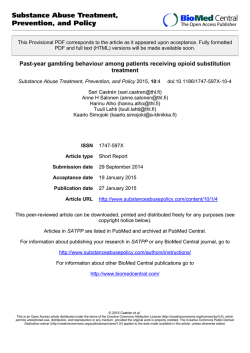
Section 94B certification guidance for Non-European
Section 94B certification guidance for Non-European Economic Area deportation cases Version 3.0 29 January 2015 Contents Section 1: Introduction Section 2: Cases not suitable for section 94B certification Section 3: When to certify a human rights claim under section 94B Section 4: Successful appeals Section 5: change record page 3 page 5 page 6 page 9 page 10 IDIs: Chapter 13 – Criminality Guidance in Article 8 ECHR Cases V3.0 (29 January2015) Page 2 of 10 Note: This Document Becomes an Uncontrolled & Unsupported Version if Printed Section 1: Introduction Purpose 1.1 This guidance explains how case owners consider certifying a human rights claim, made by a non-EEA national in the context of deportation, under section 94B of the Nationality, Immigration and Asylum Act 2002. Legislation 1.2 Section 94B of the Nationality, Immigration and Asylum Act 2002 came into force on 28 July 2014. It reads: Appeal from within the United Kingdom: certification of human rights claims made by persons liable to deportation (1) This section applies where a human rights claim has been made by a person (“P”) who is liable to deportation under— (a) section 3(5)(a) of the Immigration Act 1971 (Secretary of State deeming deportation conducive to public good), or (b) section 3(6) of that Act (court recommending deportation following conviction). (2) The Secretary of State may certify the claim if the Secretary of State considers that, despite the appeals process not having been begun or not having been exhausted, removal of P to the country or territory to which P is proposed to be removed, pending the outcome of an appeal in relation to P’s claim, would not be unlawful under section 6 of the Human Rights Act 1998 (public authority not to act contrary to Human Rights Convention). (3) The grounds upon which the Secretary of State may certify a claim under subsection (2) include (in particular) that P would not, before the appeals process is exhausted, face a real risk of serious irreversible harm if removed to the country or territory to which P is proposed to be removed. Background 1.3 Section 17(3) of the Immigration Act 2014 amended the Nationality, Immigration and Asylum Act 2002 to introduce a discretionary certification power in relation to human rights claims made by those liable to deportation under sections 3(5)(a) and 3(6) of the Immigration Act 1971. 1.4 Section 94B of the Nationality, Immigration and Asylum Act 2002 allows a human rights claim to be certified where the appeal process has not yet begun or is not yet exhausted where it is considered that the person liable to deportation would not, before the appeal IDIs: Chapter 13 – Criminality Guidance in Article 8 ECHR Cases V3.0 (29 January2015) Page 3 of 10 Note: This Document Becomes an Uncontrolled & Unsupported Version if Printed process is exhausted, face a real risk of serious irreversible harm if removed to the country of return. 1.5 The result of certification under section 94B is that the right of appeal against the decision to refuse the human rights claim will be non-suspensive, meaning it will not be a barrier to removal. Any appeal can only be heard out-of-country. The EEA Regulations have also been changed to allow non-suspensive appeals in certain EEA cases. Separate guidance is available for EEA cases here. Initial Cohort 1.6 Section 94B came into force on 28 July 2014. It was initially rolled out to a limited cohort of cases where: 1.7 the individual was aged 18 or over at the time of the deportation decision; and the individual did not have a genuine and subsisting parental relationship with a dependent child or children. That first phase came to an end on 17 October 2014. Section 55 duty 1.8 The duty in section 55 of the Borders, Citizenship and Immigration Act 2009 to have regard to the need to safeguard and promote the welfare of children who are in the UK means that a child’s best interests are a primary consideration in deportation cases. 1.9 Case owners must carefully consider all of the information and evidence provided concerning the best interests of a child in the UK, in relation to the application of the section 94B of the Nationality, Immigration and Asylum Act 2002. Case owners must carefully assess the quality of any evidence provided. Original, documentary evidence from official or independent sources will be given more weight in the decision-making process than unsubstantiated assertions about a child’s best interests. 1.10 For further guidance in relation to the section 55 duty, see: Section 55 children's duty guidance; Introduction to children and family cases; and Criminality guidance for Article 8 ECHR cases. IDIs: Chapter 13 – Criminality Guidance in Article 8 ECHR Cases V3.0 (29 January2015) Page 4 of 10 Note: This Document Becomes an Uncontrolled & Unsupported Version if Printed Section 2: Cases not suitable for section 94B certification 2.1 Human rights claims which are considered under paragraph 353 of the Immigration Rules and not accepted as a fresh claim cannot be certified under section 94B because the decision will not generate a right of appeal. 2.2 Human rights claims which can be certified under section 96 of the Nationality, Immigration and Asylum Act 2002 cannot be certified under section 94B because the decision will not generate a right of appeal. 2.3 Human rights claims which can be certified under section 94 of the Nationality, Immigration and Asylum Act 2002 should not normally be certified under section 94B because section 94 is a stronger power which will usually take precedence, and in any case will have the same effect as section 94B certification. 2.4 Protection claims made wholly or in part under Articles 2 and/or 3 of the European Convention on Human Rights cannot be certified under section 94B. This is because they must be certified under section 94 if they are clearly unfounded, and if they are not clearly unfounded, then it will be arguable that there is a real risk of serious irreversible harm. 2.5 Human rights claims from foreign criminals who are serving a determinate-length sentence where release is at the discretion of the Parole Board will not normally be suitable for section 94B certification. This includes those who were: sentenced in accordance with the Discretionary Conditional Release Scheme (DCR) under the Criminal Justice Act 1991; given an Extended Sentence for Public Protection (EPP); and given an Extended Determinate Sentence (EDS). 2.6 Human rights claims from foreign criminals who are to be deported while they are minors will not normally be suitable for section 94B certification. 2.7 Cases to which the scenarios at 2.5 and 2.6 apply will not usually be suitable for section 94B certification for practical operational reasons, not because there will necessarily be a real risk of serious irreversible harm. Consideration must be given to all cases on an individual basis about whether or not it is appropriate to certify. IDIs: Chapter 13 – Criminality Guidance in Article 8 ECHR Cases V3.0 (29 January2015) Page 5 of 10 Note: This Document Becomes an Uncontrolled & Unsupported Version if Printed Section 3: When to certify a human rights claim under section 94B 3.1 Section 94B certification must be considered in all deportation cases where a human rights claim has been made and falls for refusal unless it is a case to which section 2 of this guidance applies. The “test” phase where section 94B was rolled out to a limited cohort of cases ended on 17 October 2014 and no longer applies. 3.2 The Government’s policy is that the deportation process should be as efficient and effective as possible. Case owners should therefore seek to apply section 94B certification in all applicable cases where doing so would not result in serious irreversible harm. Real risk of serious irreversible harm 3.3 When deciding whether it is appropriate to certify a human rights claim under section 94B, case owners must consider whether an out-of-country appeal would result in a real risk of serious irreversible harm before the appeal process is exhausted. The serious irreversible harm test is derived from the European Court of Human Rights (ECtHR), which uses it to determine whether they should issue Rule 39 injunctions preventing removal. 3.4 The term “real risk” is a relatively low threshold and has the same meaning as when used to ascertain whether removal would breach ECHR Article 3. However, the terms “serious” and “irreversible” must be given their ordinary meanings. “Serious” indicates that the harm must meet a minimum level of severity, and “irreversible” means that the harm would have a permanent or very long-lasting effect. If the human rights claim is based on Article 8, case owners must consider not only the impact on the foreign criminal’s rights, but also those of any partner or child. The test relates only to the period of time between deportation and the conclusion of any appeal, and will not be met solely because the person will be separated from family members in the UK during that period. 3.5 It will not normally be enough for a person to provide evidence that there is a real risk of harm which would be either serious or irreversible. In order for certification not to be possible, there must be a real risk of harm that would be both serious and irreversible. 3.6 By way of example, in the following scenarios where a person is deported before their appeal is determined it is unlikely, in the absence of additional factors, that there would be a real risk of serious irreversible harm while an out-of-country appeal is pursued: a person will be separated from their child/partner for several months while they appeal against a human rights decision; a family court case is in progress and there is no evidence that the case could not be pursued from abroad; a child/partner is undergoing treatment for a temporary or chronic medical condition that is under control and can be satisfactorily managed through medication or other treatment and does not require the person liable to deportation to act as a full time carer; IDIs: Chapter 13 – Criminality Guidance in Article 8 ECHR Cases V3.0 (29 January2015) Page 6 of 10 Note: This Document Becomes an Uncontrolled & Unsupported Version if Printed 3.7 Although the serious irreversible harm test sets a high threshold, there may be cases where that test is met. Such cases are likely to be rare, but case owners must consider every case on its individual merits to assess the likely effect of a non-suspensive right of appeal. The following are examples of when the test might be met: 3.8 a person has a medical condition but removal would not breach Article 3; a person has strong private life ties to a community that will be disrupted by deportation (e.g. they have a job, a mortgage, a prominent role in a community organisation etc.). The person has a genuine and subsisting parental relationship with a child who is seriously ill, requires full-time care, and there is no one else who can provide that care; The person has a genuine and subsisting long-term relationship with a partner who is seriously ill and requires full-time care because they are unable to care for themselves, and there is no one else, including medical professionals, who can provide that care. The onus is on the Secretary of State to demonstrate that there is not a real risk of serious irreversible harm. However, if a person claims that a non-suspensive appeal would risk serious irreversible harm, the onus is on that person to substantiate the claim with documentary evidence, preferably from official sources, for example a signed letter on letter-headed paper from the GP responsible for treatment, a family court order, a marriage or civil partnership certificate, documentary evidence from official sources demonstrating long-term co-habitation, etc. Case owners should expect to see original documents rather than copies. Dual certification 3.9 If a protection claim is certified under sections 94 or 96, but it is not possible to certify a linked Article 8 claim (or other non-protection human rights claim) under either of those powers, then consideration must be given to certifying the Article 8 claim under section 94B as long as there is not a real risk of serious irreversible harm. Timing of certification 3.10 Case owners need to bear in mind that it is possible to certify under section 94B at any stage in the process as long as the person has not exhausted their appeal rights. In practice, this means that if a claim is not certified at the initial decision stage, and either party challenges the decision of the First-tier Tribunal (or that of the Upper Tribunal), the case owner must consider whether it is appropriate to certify the claim before it is heard by the Upper Tribunal (or the Court of Appeal). 3.11 For example, if a person has an in-country appeal against the refusal of a nonprotection claim solely because they were entitled to an in-country appeal against the refusal of a protection claim, and the appeal progresses to the Upper Tribunal (regardless of whether it was allowed or dismissed at the First-tier Tribunal), it may be the case that the protection claim is no longer relied upon, and the only part of the claim that remains is an Article 8 claim. If so, and there is not a real risk of serious irreversible harm, and, it is likely that certification will be appropriate particularly, as a matter of policy, if the person is otherwise removable (e.g. a travel document is now available). IDIs: Chapter 13 – Criminality Guidance in Article 8 ECHR Cases V3.0 (29 January2015) Page 7 of 10 Note: This Document Becomes an Uncontrolled & Unsupported Version if Printed 3.12 If it is decided to certify at any stage after the person has lodged an appeal, the case owner must notify the relevant Court or Tribunal in writing. 3.13 All certification decisions, including decisions not to certify, need to be subject to a peer review process. Reasons for the certification decision, including not certifying, must be clearly set out in CID notes and the case file. This is because a decision to certify can be challenged by judicial review and the Home Office may be required to provide records of the decision-making process. IDIs: Chapter 13 – Criminality Guidance in Article 8 ECHR Cases V3.0 (29 January2015) Page 8 of 10 Note: This Document Becomes an Uncontrolled & Unsupported Version if Printed Section 4: Successful appeals 4.1 Where a foreign criminal’s out-of-country appeal against the refusal of a non-protection human rights claim succeeds, the foreign criminal is entitled to return to the UK and the deportation order must be revoked. 4.2 Consideration must be given to whether the Home Office should pay for the foreign criminal’s journey back to the UK if this is requested by the foreign criminal. 4.3 In considering whether to pay for the foreign criminal’s journey back to the UK, regard should be had to the following factors: the quality of the Home Office’s decision to refuse the human rights claim; whether the appeal was allowed on the basis of evidence or information that the foreign criminal failed to submit to the Home Office in advance of his deportation despite a section 120 warning, and if so, whether there is any reasonable explanation for this; whether there is evidence that if the Home Office does not pay for the return journey the foreign criminal be unable to return to the UK even though the human rights decision requires him to be able to return. 4.4 Where a person was accepted onto the Facilitated Return Scheme (FRS) and received financial assistance to leave the UK, but then appeals the refusal of a human rights claim abroad and wishes to return to the UK, the Home Office should not usually pay for their journey back to the UK. IDIs: Chapter 13 – Criminality Guidance in Article 8 ECHR Cases V3.0 (29 January2015) Page 9 of 10 Note: This Document Becomes an Uncontrolled & Unsupported Version if Printed Section 5: change record Version Author(s) Date Change References 1.0 LS (CPT) 28/07/2012 First draft. 2.0 LC (CPT) 20/10/2014 Added section 1: introduction; added a link to the EEA guidance; added section 2: when not to certify; combined “real risk of serious irreversible harm” into section 3: when to certify and added “dual certification”; added section 4: successful appeals; added section 5: change record. 3.0 LS(CPT) 20/1/2015 Removed a drafting error in paragraph 1.3 IDIs: Chapter 13 – Criminality Guidance in Article 8 ECHR Cases V3.0 (29 January2015) Page 10 of 10 Note: This Document Becomes an Uncontrolled & Unsupported Version if Printed
© Copyright 2025
